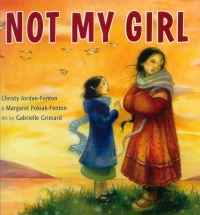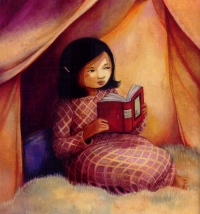| ________________
CM . . .
. Volume XX Number 40. . . .June 13, 2014
excerpt:
In Not My Girl, Christy Jordan-Fenton and Margaret Pokiak-Fenton continue the journey that started in When I Was Eight. The original book, When I Was Eight, covers protagonist Olemaun’s desire to read, her early days at residential school, and her transformation into Margaret. Not My Girl picks up Margaret’s story two years later as she returns home to her family in Aklavik. As with When I Was Eight, the story is told through Margaret’s first person narrative and focuses on her feelings and experiences. Both picture books are adaptations of award-winning books for middle grade readers, Fatty Legs and A Stranger at Home: A True Story.
Margaret’s father is the only one to recognize her as Olemaun: “I had not heard my Inuit name in so long I thought I might shatter like an eggshell with the weight of my father’s voice” (p. 5). Through a powerful use of simile, this description invites readers to empathize with Margaret. Jordan-Fenton and Pokiak-Fenton, by choosing an object with a commonly associated quality like an eggshell and fragility, make it easy for young readers to imaginatively place themselves in Margaret’s shoes. The use of “weight” to describe a voice can serve as an excellent example for children as they develop more sophisticated language skills and varied ways of describing their feelings, perceptions and experiences. The facing illustration (p. 6) offers additional encouragement for readers to consider how Margaret feels. Since the picture’s perspective is from Margaret’s eye level rather than her father’s, he looms over in her a comforting posture. Young readers will recognize themselves in this picture and will be able to draw a connection between their memories of being comforted by a parent and Margaret’s experience. Perceptive readers may also note the sad expression on her father’s face that goes unnoticed by Margaret, the story’s narrator, and, therefore, is not mentioned in the text. This visual storytelling gives readers another perspective to consider. The multiple layers that this story provides create excellent learning opportunities for exploring points of view, empathy, and emotional intelligence. Margaret wonders about her place in her family and her community: she can no longer speak her family’s language, eat her family’s food, or contribute to their table. Even her school friend Agnes, her only potential sympathizer, can no longer be part of her life. Margaret’s feelings of alienation are expressed in evocative language that engages with multiple sense: “As they honked away like a gaggle of geese, I wondered what kind of bird I had become. I no longer felt like I belonged to this flock” (p. 10). The burden of residential school never quite leaves Margaret even as she re-adjusts to life in Aklavik. However, Jordan-Fenton and Pokiak-Fenton are never heavy-handed with the references; they weave in mentions to “school” with grace and subtlety for careful readers to notice. As a teaching tool, this story can be used to model the ideas of resilience and self-esteem. While readers may expect a quick resolution, Not My Girl refuses to reduce a complicated situation to a simple plot structure. Margaret faces ups and downs as she tries to find a new place for herself in her family and community. At her lowest point, she draws on the wisdom of her grandmother and finds the courage to take on challenges. While the story is, at times, saturated with feelings of loneliness and isolation, it moves at a pace such that readers are continually engaged and invested in Margaret’s journey. Her eventual triumph, with her mother proudly exclaiming “My girl!” (p. 34), becomes that much more meaningful due to the connection that readers have to her as a well-rounded and nuanced character. By featuring a photograph of Margaret with her parents on the title page, young readers are able to draw a connection between the character and the real Margaret Pokiak and give life to the past. In Not My Girl, Jordan-Fenton and Pokiak-Fenton have been able to tell a difficult and emotional story in a way that is relatable and engaging for young readers. Not My Girl and the original book, When I Was Eight, are must-adds to any Canadian classroom or library. Highly Recommended. Sabrina Wong is a librarian at the University of Calgary.
To comment
on this title or this review, send mail to cm@umanitoba.ca.
Copyright © the Manitoba Library Association. Reproduction for personal
use is permitted only if this copyright notice is maintained. Any
other reproduction is prohibited without permission.
NEXT REVIEW |
TABLE OF CONTENTS FOR THIS ISSUE
- Junw 13, 2014.
AUTHORS |
TITLES |
MEDIA REVIEWS |
PROFILES |
BACK ISSUES |
SEARCH |
CMARCHIVE |
HOME |
||||||

 Writers Jordan-Fenton and Pokiak-Fenton have an incredible gift for storytelling and the ability to capture the hearts of their readers. Their rich prose draws on bird and nature metaphors to effectively and beautifully convey Margaret’s feelings. Illustrator Gabrielle Grimard’s soft and painterly style enriches the clarity and beauty of Jordan-Fenton and Pokiak-Fenton’s prose. Grimard draws on a mix of watercolour, gouache, oil paint and coloured pencil to create illustrations with incredible depth. Her talent in depicting emotional tone is expressed in her ability to depict facial expressions with sensitivity and grace as well as the composition of her illustrations. The opening spread (pp. 1-2) shows Margaret’s return to Aklavik. One page shows a cluster of happy mothers and daughters embracing while, on the facing page, Margaret and her mother stand separated by a dock. Margaret, dressed in her blue uniform with short hair, expresses uncertainty in both her face and posture as she faces her mother. Margaret’s mother, dressed in red with long windblown braids, has her back turned to the reader. Her expression is hidden from the reader, and so the reader is made to feel as much a stranger to her as Margaret feels when she calls out, “Not my girl!” (p. 2). Using visual contrasts, Grimard is able to visually communicate the emotional gulf between mother and daughter.
Writers Jordan-Fenton and Pokiak-Fenton have an incredible gift for storytelling and the ability to capture the hearts of their readers. Their rich prose draws on bird and nature metaphors to effectively and beautifully convey Margaret’s feelings. Illustrator Gabrielle Grimard’s soft and painterly style enriches the clarity and beauty of Jordan-Fenton and Pokiak-Fenton’s prose. Grimard draws on a mix of watercolour, gouache, oil paint and coloured pencil to create illustrations with incredible depth. Her talent in depicting emotional tone is expressed in her ability to depict facial expressions with sensitivity and grace as well as the composition of her illustrations. The opening spread (pp. 1-2) shows Margaret’s return to Aklavik. One page shows a cluster of happy mothers and daughters embracing while, on the facing page, Margaret and her mother stand separated by a dock. Margaret, dressed in her blue uniform with short hair, expresses uncertainty in both her face and posture as she faces her mother. Margaret’s mother, dressed in red with long windblown braids, has her back turned to the reader. Her expression is hidden from the reader, and so the reader is made to feel as much a stranger to her as Margaret feels when she calls out, “Not my girl!” (p. 2). Using visual contrasts, Grimard is able to visually communicate the emotional gulf between mother and daughter.